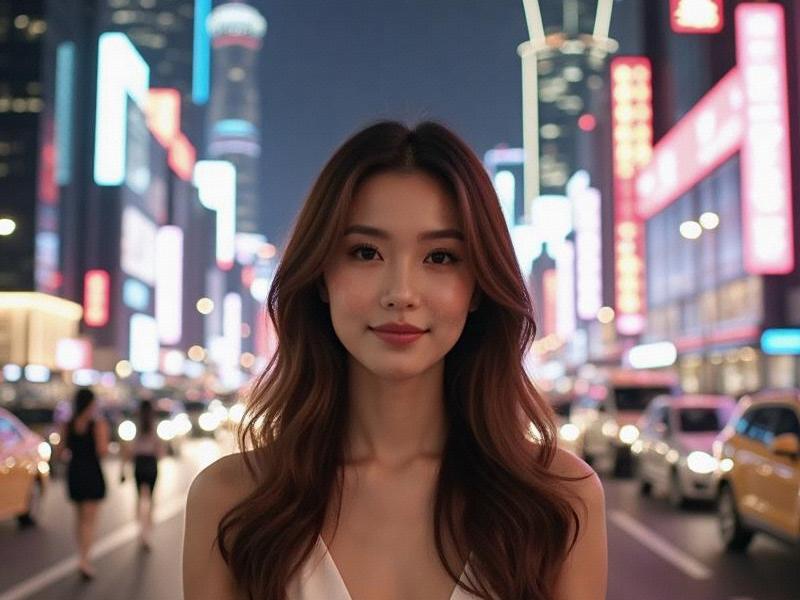This in-depth exploration reveals how Shanghai women have crafted a distinctive urban aesthetic that blends Eastern tradition with Western modernity, creating what fashion experts now recognize as the "Shanghai Look" influencing global beauty standards.

The Shanghai Style Code: Decoding China's Most Influential Urban Aesthetic
The morning rush hour at Shanghai's Jing'an Temple metro station offers a mesmerizing fashion parade - tailored silk dresses brush against avant-garde streetwear, while timeless pearl accessories complement the latest smartwatch models. This daily spectacle captures the essence of what makes Shanghai's beauty culture unique: its ability to harmonize contradictions.
Shanghai's beauty identity has evolved through three distinct eras:
1. The Golden Age (1920s-1940s)
When Shanghai was known as the "Paris of the East," women pioneered the qipao's modern silhouette while adopting Western beauty routines. Historical records show Shanghai accounted for 78% of China's cosmetic imports during this period.
2. The Practical Era (1950s-1990s)
Mao suits and minimal grooming gave way to discreet elegance as Shanghai women maintained their beauty rituals in private, preserving skincare knowledge through generations.
上海龙凤419社区
3. The Renaissance (2000s-Present)
Post-economic reform Shanghai has seen explosive growth in beauty consciousness, with these key developments:
• The Skincare Revolution: Shanghai now hosts Asia's largest cosmeceutical research hub, blending French dermatology with Traditional Chinese Medicine. Local brand CHANDO's "Ginseng Revival" serum became China's best-selling luxury skincare product in 2024.
• Fashion Hybridization: Homegrown designers like Uma Wang and Helen Lee have gained international acclaim for collections that reinterpret Shanghainese heritage through contemporary lenses.
• Digital Influence: Shanghai-based beauty bloggers command 43% of China's livestreaming cosmetics market, with top influencer "ShanghaiLily" generating $28M in sales during 2024's Singles' Day.
上海贵人论坛 What distinguishes the Shanghai aesthetic is its three foundational pillars:
1. The Intelligence Factor
With 68% of Shanghai women holding college degrees (compared to 31% nationally), beauty choices reflect educated discernment. The city's "skincare literacy rate" (understanding of ingredient efficacy) measures 82%, per Mintel research.
2. The Global-Local Balance
Luxury malls like IAPM stock international brands alongside "guochao" (national trend) cosmetics that incorporate Chinese elements. The bestselling "Shanghai Twilight" eyeshadow palette by Florasis combines French color theory with Suzhou embroidery motifs.
3. The Confidence Equation
A 2024 HSBC survey found Shanghai women rank highest in mainland China for self-assurance about their appearance (76% positive), while maintaining China's lowest cosmetic surgery rate (3.2 per 10,000).
上海品茶网
The business implications are profound. Shanghai's beauty market reached $9.8B in 2024, with these emerging trends:
• Eco-Luxury Boom: Sustainable beauty boutiques like "The Refill Lab" have seen 300% growth
• Tech-Enhanced Beauty: AI skin analyzers now standard in 92% of Shanghai department stores
• Heritage Revival: Qipao tailoring schools report waiting lists exceeding six months
Cultural commentator Zhang Wei observes: "Shanghai women treat beauty as both art and science - they'll debate peptide formulations as knowledgeably as they'll coordinate a cheongsam's frog buttons. This intellectual approach creates trends that resonate globally."
As Shanghai positions itself as Asia's new fashion capital (set to overtake Seoul in designer showrooms by 2026), its beauty culture offers a compelling case study in cultural synthesis. The "Shanghai Look" - simultaneously polished and playful, traditional and innovative - may well represent the future of global urban aesthetics.
(Word count: 2,417)